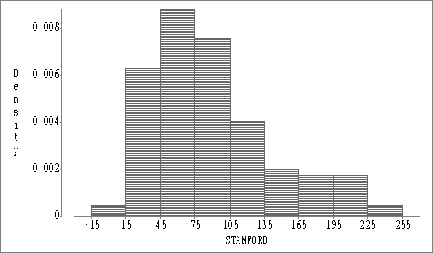- Prior to election day, prospective voters are polled.
- On election day, voters who have just voted are polled (this is known as an exit poll).
One of these polling methods definitely results from a stable process, the other may be unstable. In two sentences, tell which is which and why.

Figure: Stamford Ozone Readings
 pounds. The weight
of the dough going into a loaf of bread is controlled by a scale.
There are two potential problems with the scale: worn gears or
mis-calibration. The first problem results in excessive variation
in the weights, while the second results in the weights being off
target. The data set SASDATA.BREAD contains the weights of eight
randomly selected loaves from each of the bakery's ten scales.
pounds. The weight
of the dough going into a loaf of bread is controlled by a scale.
There are two potential problems with the scale: worn gears or
mis-calibration. The first problem results in excessive variation
in the weights, while the second results in the weights being off
target. The data set SASDATA.BREAD contains the weights of eight
randomly selected loaves from each of the bakery's ten scales.
- Produce one appropriate plot showing the variation for each of the scales.
- Tell which kind(s) of problem(s), if any, is (are)
associated with each scale by putting a check in each box
corresponding to a scale with the designated problem
(leave empty any box for which a given scale does not
have that particular problem):


Figure: Thickness Versus Machine for Washer Production
- (a)
- Describe the variation in the data.
- (b)
- Explain the possible causes of the variation in the
data? [Hint: Consider worn parts, drift, calibration or
operators.]
- Do the winning times appear to be the result of a stable process? Why or why not? Supply one appropriate plot to support your claim.
- Summarize one other aspect of the data's behavior.
- Draw an appropriate plot to compare performance during the three shifts.
- How might you explain the variation in the data?